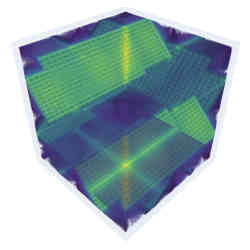
Artificial intelligence (AI)—in particular, machine learning (ML)— recently began to solve problems for which quantum computers are targeted, according to researchers at the California Institute of Technology (CalTech), the Flatiron Institute (New York City), and IBM (Yorktown Heights, NY).
"ML cannot emulate every quantum algorithm," said Hsin-Yuan Huang, a quantum information theorist at CalTech, "but ML can emulate more quantum algorithms than classical algorithms that do not have learning abilities. For example, to solve the problem of finding quantum ground states [lowest energy levels], one typically wants to use adiabatic [thermodynamic] quantum algorithms. But we've proven that a classical ML model can learn from data to predict these ground states efficiently."
Quantum computers, once thought to be "superior" to classical computers, increasingly are being seen as yet another accelerator for specialized problems, according to IBM, which is developing what it calls neuro-symbolic AI—an ML method using classical computer hardware. IBM also is experimenting with hyperdimensional ML accelerators to work alongside classical computer hardware. These alternative accelerator architectures are being developed in parallel with its continued development of quantum computer accelerators for classical computers.
"Quantum computers will never reign 'supreme' over classical computers, but [like other accelerator architectures] will rather work in concert with them, since each have their unique strengths," according to IBM Research's Jay Gambetta, John Bunnels, Dmitri Maslov, and Edwin Penault, who wrote an IBM Research Blog post in 2019 arguing that the claim of quantum "supremacy" over classical computers is flawed.
The Classical Advantage
More recently, physicists at New York City's Flatiron Institute, in association with the University of Bologna, Italy, reported a 25,000-times speed-up in solving a daunting quantum problem using classical computers accelerated by ML. The Flatiron Institute research, led by visiting researcher Domenico Di Sante, demonstrated a solution to the quantum physics many-body problem that future quantum computers will aim to solve, but which classical computers struggle with today. By harnessing AI along with classical computer algorithms, the Flatiron Institute researchers reduced the problem of solving 100,000 coupled differential equations to just four.
Explained Di Sante, an assistant professor of the University of Bologna currently in residence at the Flatiron Institute's Center for Computational Quantum Physics, "Differential equations form the language used to model almost all physical phenomena in both the classical and the quantum world, from weather forecasts to the evolution of the universe to the dynamics of quantum electrons and subnuclear particles. All ambits of physical modeling benefit from tackling the problem of a large number of coupled differential equations. In this sense, our new data-driven approach to compress the complexity of many-body problems will be helpful to both classical and quantum fields."
Since classical computers using Di Sante's ML algorithms can simplify the solution of problems previously thought to require future quantum computers to solve efficiently, its accomplishment mitigates the need for full-blown universal quantum computers.
"Efficiently solving for the effective interaction among many-particles is a big deal in quantum physics, especially for interactions within quantum materials. It saves memory, computational power, and offers physical insight. Our work demonstrates how ML and quantum physics intersect constructively. It is difficult to quantify what will be our work's direct impact on quantum computers, but that field is facing the same problem—large, high-dimensional data sets that need compression in order to manipulate and study efficiently," said Di Sante. "I would love to discover that our more-efficient solution method can shed light onto the intricate nature of future quantum computer architectures."
One caveat to Di Sante's approach is that the entire body of 100,000 equations must first be solved (which, in this example, took weeks of classical computer time). His ML algorithm then derived from that solution the smallest set of equations that could provide a specified level of accuracy. Hopefully, now that the ML algorithm has been constructed, future tweaking of it will enable the group to solve similar quantum problems without requiring weeks of preliminary computer time.
One Step Beyond
Other research groups have been following similar paths in integrating AI algorithms to solve quantum problems on classical computers, but without the weeks-long preparatory computer time of Di Sante's solution. One such group working with the U.S. National Institute of Science and Technology and Johannes Kepler University of Linz, Austria, recently demonstrated new results at CalTech. Instead of devoting weeks of classical computer time to first solving the gigantic space of purely mathematical equations describing a many-body interaction, this group used its ML algorithm to analyze empirical many-body data measured in the real world. Although applicable only to a single problem—since empirical data is only available to be collected from specific cases—this method avoids the long weeks of preparatory computer time using Di Sante's approach.
The group, led by Caltech's Institute for Quantum Information and Matter, proved that ML combined with classical computers also can solve a quantum many-body problem (efficiently predicting not only the ground-state of a quantum material, but also classifying the quantum phases of the material, and similar problems that future full-blown quantum computers also will be able to solve efficiently.)
Caltech agrees using ML with classical computers cannot emulate every quantum algorithm. However, ML accelerators for classical computers have now been demonstrated by these researchers to emulate more quantum algorithms than classical algorithms that are not based on learning.
The landscape is improving, according to Huang. CalTech first solved the quantum ground state problem for its particular case, then reapplied that algorithmic approach to predict quantum phases of matter, raising the group's hope that it can apply the approach to other quantum problems as well.
R. Colin Johnson is a Kyoto Prize Fellow who has worked as a technology journalist for two decades.



Join the Discussion (0)
Become a Member or Sign In to Post a Comment